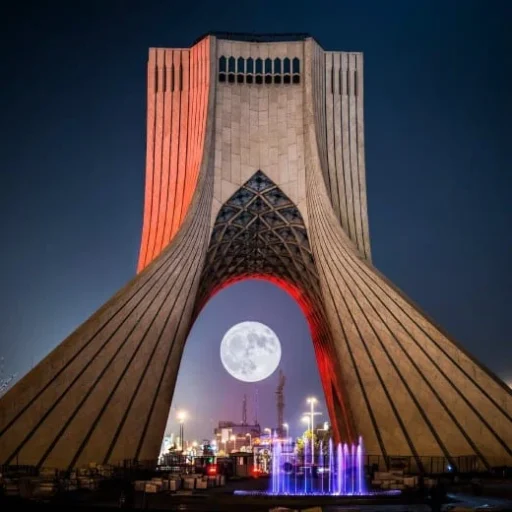
Azadi Tower (Borj-e Azadi) is not just a monument—it’s one of the most famous landmarks in Tehran and a powerful symbol of Iranian identity. Whether you’re a traveler exploring Tehran’s tourist attractions or a culture lover diving into Persian heritage, visiting Azadi Tower is a must. This guide explores the tower’s history, architecture, and museum, helping you appreciate one of Iran’s most iconic structures.
What Is Azadi Tower?
Azadi Tower, originally named Shahyad Tower (“King’s Memorial Tower”), is a monumental structure located in Azadi Square, western Tehran. It was built in 1971 to commemorate the 2,500th anniversary of the Persian Empire and is now a national symbol of freedom, unity, and Iranian pride.
After the 1979 Islamic Revolution, the monument was renamed “Azadi” meaning “Freedom.” Today, it stands as one of the most popular tourist attractions in Tehran, welcoming thousands of visitors annually.
History of Azadi Tower
Origins and Purpose
The tower was commissioned by Mohammad Reza Shah Pahlavi, the last Shah of Iran, as part of a broader campaign to modernize and celebrate Iran’s long-standing empire. The goal was to build a structure that could represent both Iran’s ancient heritage and its vision for the future.
Post-Revolution Identity
After the revolution in 1979, the tower’s name and symbolism changed, reflecting the public’s aspiration for freedom and change. Today, The tower holds significance not just as an architectural marvel but also as a site of cultural and political history in Iran.
Azadi Tower Architecture – A Blend of Ancient Persia and Modern Design
Designed by Hossein Amanat
At only 24 years old, Iranian-Canadian architect Hossein Amanat won the national design competition for the project. His vision fused Sassanid, Achaemenid, and Islamic architectural elements with modern engineering, creating a truly unique structure.
Key Architectural Features
- Height: 45 meters (148 feet)
- Material: Over 8,000 white marble stones from Esfahan
- Shape: A parabola with intersecting arches resembling traditional Persian iwans
- Design inspiration: Drawn from Persepolis, Islamic arches, and pre-Islamic Iranian geometry
The white marble reflects sunlight differently throughout the day, creating an ever-changing visual experience—making it a favorite subject for photographers and Instagram users looking for Tehran photography spots.
Inside Azadi Tower: The Underground Museum
What many don’t know is that beneath this monumental structure lies the Azadi Tower Museum, an underground cultural center showcasing Iranian history and craftsmanship.
What to See at the Museum
- Historical Exhibits – View artifacts from ancient Persia, including pottery, manuscripts, and bronze sculptures.
- Multimedia Presentations – Watch films about the construction and meaning of the tower in Persian and English.
- Islamic and Persian Art – Admire mirror work, calligraphy, and detailed mosaics in traditional Persian style.
- Architectural Display – See original design plans and architectural features that highlight the creative process of building the tower.
The museum provides an educational and cultural experience, offering deeper insight into Iranian civilization, both past and present.
Why Visit Azadi Tower?
1. Cultural Significance
The tower is deeply tied to Iran’s national identity. It has been the site of celebrations, political protests, and national events, including the anniversary of the Islamic Revolution and Nowruz (Persian New Year) festivities.
2. Architectural Wonder
Combining traditional Persian architecture with modern design, the tower represents the fusion of Iran’s heritage with its modern aspirations.
3. Great for Tourists
Easily accessible by Tehran Metro and close to Mehrabad International Airport, it’s one of the most convenient landmarks to visit in Tehran. Plus, it’s free to admire from outside and offers budget-friendly entry to the museum and viewing platform.
How to Visit Azadi Tower – Practical Tips for Tourists
📍 Location:
- Azadi Square, western Tehran, near major roads and public transport
- Metro Station: Azadi Square (Line 4)
🕒 Opening Hours:
- 9:00 AM – 6:00 PM (may vary on holidays)
- Closed on official mourning days
💵 Entry Fee:
- Affordable, includes access to the museum and observation deck
📸 Photography Tips:
- Visit during sunset for golden-hour photos
- Use a wide-angle lens to capture the full height
- The monument is stunning in both daylight and nighttime lighting
Nearby Attractions to Combine with Your Visit
- Tehran Museum of Contemporary Art
- Mehrabad Airport (ideal for short layovers)
- Laleh Park – A peaceful green space
- Azadi Stadium – For sports enthusiasts
Best Time to Visit Azadi Tower
The best seasons to explore Tehran are spring (March–May) and autumn (September–November). These months offer pleasant weather, fewer crowds, and clearer skies—perfect for outdoor sightseeing and photography.
Stay Near Azadi Tower with Azadi Hospitality
If you’re looking for a comfortable, affordable, and authentic Tehran homestay near Azadi Tower, look no further than Azadi Hospitality. Our guesthouses and homestays offer:
- Local Iranian culture and cuisine
- Proximity to Tehran’s top landmarks
- Helpful hosts who provide travel tips, transportation support, and more
With Azadi Hospitality, your visit to Tehran becomes a cultural immersion, not just a stay.
Conclusion: Azadi Tower is More Than a Landmark—It’s the Heart of Tehran
Azadi Tower stands as a monument to freedom, unity, and architectural brilliance. Its history reflects the evolution of Iranian society, its architecture honors centuries of Persian design, and its museum educates visitors on Iran’s rich culture.
Whether you’re visiting Tehran for the first time or returning to rediscover the city, Azadi Tower should be on every traveler’s itinerary.
For travelers seeking a complete experience near Azadi Tower, book your stay at Azadi Hospitality for personalized service, cultural immersion, and memorable hospitality.
Direction to Azadi Tower from our homestay:
